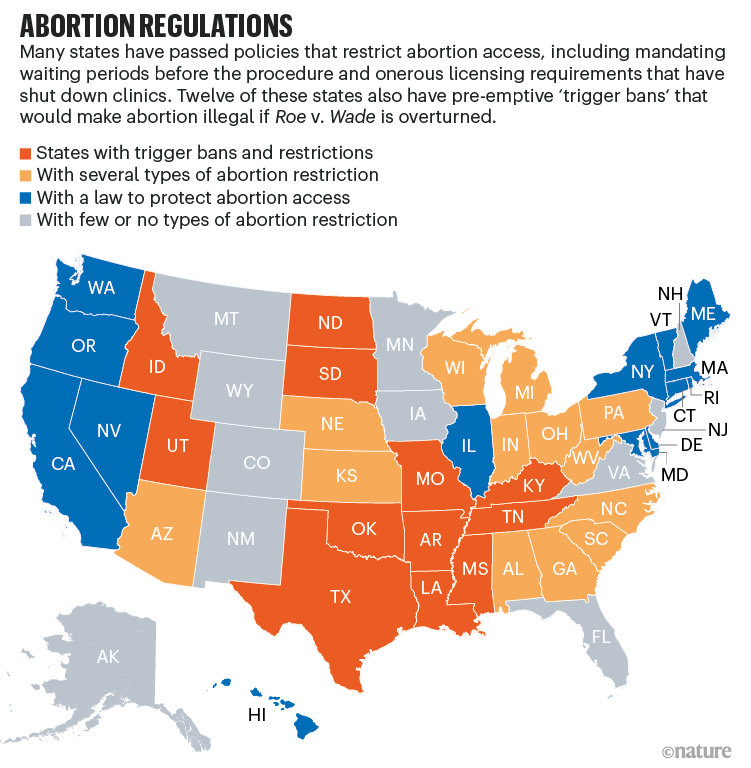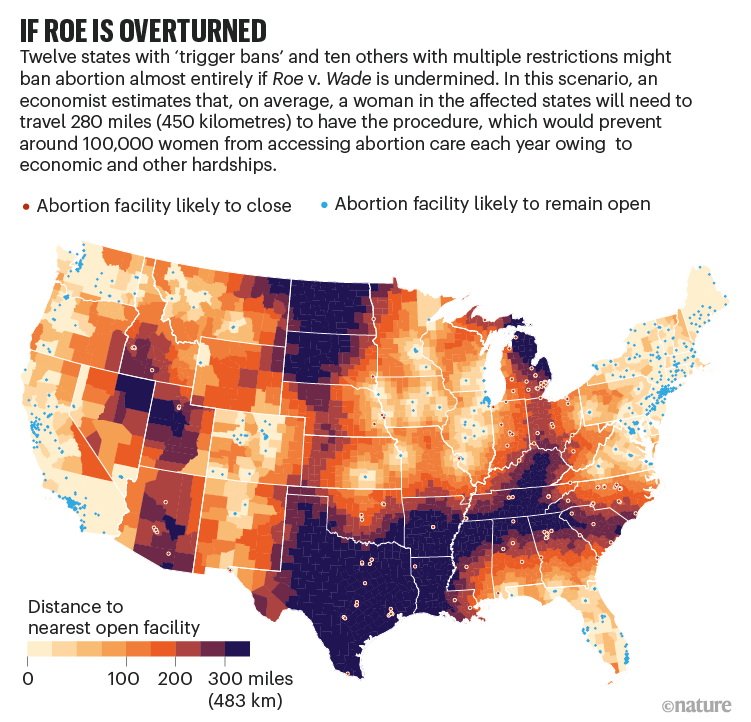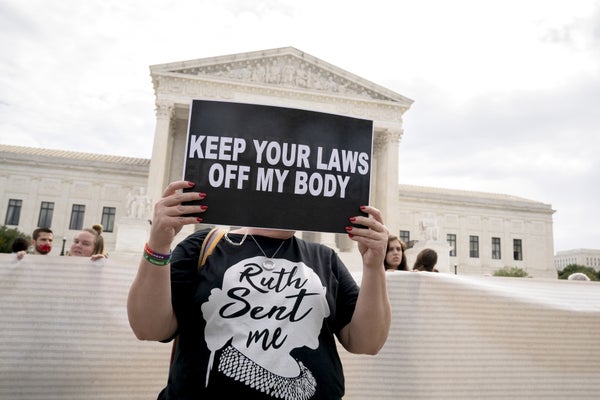An upcoming case in the US Supreme Court might hasten the end of abortion across roughly half of the United States—a right that the country has defended for nearly 50 years. More than 800 scientists and several scientific organizations have provided evidence to the court showing that abortion access is an important component of reproductive healthcare.
The researchers, some of whom have studied the impact of abortion for many years, are rebutting arguments made to the court that abortion has no beneficial effect on women’s lives and careers—and might even cause them harm. “The scientific community is eager to weigh in on such an important issue, especially given five decades of evidence concerning the importance of abortion access,” says Stephanie Toti, a director at the New York City-based Lawyering Project, a group that advocates for abortion access in the United States. She adds, “This case is a big deal.”
The case, to be heard by the Supreme Court on 1 December, is between the state of Mississippi, which has issued a ban on abortion after 15 weeks of pregnancy, and the Jackson Women’s Health Organization, the only clinic in the state that provides abortions. In lower US courts, the clinic has successfully argued that the ban violates Roe v. Wade, the landmark 1973 Supreme Court decision that enshrined the federal right to an abortion until the point that a fetus can live outside the womb—a ‘viability standard’ typically set at 22 or 24 weeks of pregnancy. But state officials are now taking the case to the highest court, seeking to end the precedent set by Roe so that individual states can set their own rules on the legality of abortion. In a surprise move last week, the Supreme Court announced that it would also hear a separate case on an abortion ban in Texas on 1 November; that decision has the potential to hobble Roe by allowing states to ignore the viability standard.
On supporting science journalism
If you're enjoying this article, consider supporting our award-winning journalism by subscribing. By purchasing a subscription you are helping to ensure the future of impactful stories about the discoveries and ideas shaping our world today.
Since Roe, many states have diminished abortion access by, collectively, issuing more than 1,000 restrictions on the procedure, the majority in midwestern and southern states (see ‘Abortion regulations’). But legal analysts say the Mississippi case is the first in the Supreme Court in 30 years that could directly overturn or significantly undermine that long-standing precedent. Some analysts think that is likely to happen, judging from the court’s current composition. Former US president Donald Trump promised to appoint Supreme Court justices who would reverse Roe, and succeeded in replacing three justices during his presidency: there are now six conservative justices who have said that they disagree with abortion precedents, and three liberal justices. Should the court effectively end Roe, 12 states have policies designed to ban most abortions immediately, and—on the basis of existing and pending policies—researchers predict that another 8 to 10 could follow suit.

Credit: Nature https://doi.org/10.1038/d41586-021-02834-7; Source: Guttmacher Institute
With much at stake, many people on both sides of the abortion debate—including scientists, religious leaders and athletes—have filed a total of more than 130 ‘amicus’, or ‘friend of the court’, briefs to the Supreme Court in advance of the Mississippi case, Dobbs v. Jackson Women’s Health Organization. A handful of the briefs are authored by hundreds of researchers in public health, social science, health equity and economics, who urge the court to uphold abortion rights on the basis of dozens of peer-reviewed studies examining the effects of abortion on well-being.
Rosie Griffin, an attorney at the law firm Feldesman Tucker Leifer Fidell in Washington DC, which filed an amicus brief signed by almost 550 researchers in public-health, reproductive-health and health policy, along with the American Public Health Association and two research institutes, says her firm felt it was important for scientists to weigh in, even though the justices aren’t obliged to rely on this type of report.
“This is a coalition of folks who have spent their working lives looking at objective measures of maternal and child health,” says Griffin, “and who read Mississippi’s court filings, as well as those in favour of its argument, and said, ‘These claims are not at all supported by the data.’”
Reliable data
State restrictions, dictating, for instance, that teenagers must obtain parental consent for abortion, have been fought in courts for decades. The most recent major Supreme Court decision on abortion—Planned Parenthood v. Casey in 1992—determined that judges must weigh the reasons for new regulations against the obstacles they create for people seeking abortions. But data to help inform such decisions have been lacking.
This gap was noted by former conservative Supreme Court justice Anthony Kennedy in a 2007 case that upheld a ban on one abortion procedure. Ruling in favour of the restriction, Kennedy decided that it was protecting women from depression and a loss of self-esteem. “While we find no reliable data to measure the phenomenon, it seems unexceptionable to conclude some women come to regret their choice,” he said in his opinion.
But as he wrote those words, studies to supply such data were in the works. Chief among them was an initiative to compare women who had abortions with those who wanted them, but were turned away from clinics for various reasons, including state restrictions or a lack of doctor availability. Called the Turnaway Study, the effort followed about 1,000 women in the United States for five years after they sought abortions. The women were similar in terms of physical, mental and economic well-being initially, but diverged over time.
In more than 40 reports published in peer-reviewed scientific journals, researchers analysed what happened to the women, adjusting for potential confounding factors such as age. The overall finding was that, on average, receiving an abortion didn’t harm women’s mental or physical health, but being denied an abortion resulted in some negative financial and health outcomes.
“The science clearly shows that abortion is incredibly common, and it is important to women living full lives,” says Diana Greene Foster, leader of the Turnaway Study and a reproductive-health researcher at the University of California, San Francisco. Recent years have seen the Turnaway and other studies referenced in abortion court cases. For example, judges have cited a 2018 National Academies of Sciences, Engineering, and Medicine report finding that abortion is safe. This and other reports find that mortality rates are nearly 4 times as high for colonoscopies—and 14 times as high for childbirth — as for legal abortion procedures.
Phillip Levine, an economist at Wellesley College in Massachusetts who studies social issues, but didn’t sign an amicus brief because he refrains from abortion-policy advocacy, says the Turnaway Study represents an important advance because it’s designed to answer questions about the long-term effects of abortion and abortion denial on individuals. “That is a very hard thing to do,” he explains. He adds that his confidence in the study’s results is bolstered by similar findings in Sweden, Finland and the former Czechoslovakia. “Answering these questions perfectly is essentially impossible,” he explains, because researchers can’t conduct clinical trials on the subject. “But the Turnaway Study is some of the best evidence we have.”
The health argument
The amicus briefs authored by hundreds of scientists ahead of the Mississippi case address a particular line of argument made by state attorney-general Lynn Fitch and her colleagues in their court filing—namely, that abortion is unnecessary and possibly harmful to women. “Roe and Casey block the States and the people from fully protecting unborn life, women’s health, and their professions,” Fitch and her colleagues write.
They argue that abortion access is no longer necessary because women have the ability to succeed in their professional lives without it. This, the brief explains, is due to the availability of highly effective contraceptives; state assistance, such as adoption services; and policies including those that prevent employers from discriminating on the basis of pregnancy. In a September interview, Fitch said that banning abortion would actually empower women to raise children while pursuing careers.

Credit: Nature https://doi.org/10.1038/d41586-021-02834-7; Source: Caitlin Myers/Middlebury College
But half a century of evidence—much of it accumulating in the past decade—runs contrary to these claims, Foster says. Those data appear in the amicus brief that she helped draft with about 100 social scientists who study abortion. It cites, for example, a 2017 report finding that women who had abortions were no more depressed or anxious than those who wanted one but couldn’t get it, and a 2019 study of nearly 900 revealing that women who sought but were unable to get abortions reported higher rates of chronic headaches and joint pain five years later, compared with those who got an abortion.
Allowing states to ban abortion might even increase maternal and infant mortality rates, according to the brief signed by about 550 public-health and reproductive-health researchers. Unwanted pregnancies are associated with worse health outcomes for several reasons, including that people who plan their pregnancies tend to change their behaviour—drinking less alcohol, for example—and receive prenatal medical care long before those who are surprised by their pregnancy and don’t want it.
In addressing whether contraceptives obviate the need for abortion, the research briefs point out that abortion is still common—nearly one in four women in the United States will have an abortion by age 45. The briefs also discuss how birth control is fallible, and that young people and poor people have less access to it. That is one reason why, in the United States as of 2011, women living below the federal poverty level had five times the rate of unintended pregnancies seen in women with high incomes.
About one-quarter of people in poverty in the United States are Black. Joia Crear-Perry, president of the National Birth Equity Collaborative in Washington DC, warns that banning abortion would disproportionately harm the physical, mental and economic well-being of Black people with the capacity for pregnancy. In particular, Crear-Perry is concerned that abortion bans will raise the already dire rates of maternal mortality for Black women in the United States—which currently stand at 44 deaths per 100,000 births, four times the global average for high-income countries. The amicus brief that she co-signed with other health-equity researchers and advocates states: “Black women, in particular, who continue to experience the effects of racially-motivated policies and practices that impact their maternal health, must have the right to decide whether to continue a pregnancy to term.”
The empowerment argument
Mississippi’s assertion that abortion access has nothing to do with women’s ability to pursue careers, higher education and financial stability is supported by an amicus brief signed by anti-abortion organizations and a group that describes itself as 240 women scholars and professionals, who have degrees in law, medicine and other subjects. "Women do not need abortions to achieve," says Michele Sterlace-Accorsi, the executive director of the organization Feminists Choosing Life of New York, and a signatory on the brief. It criticizes the Turnaway Study and others that link the right to abortion to women’s health and empowerment, saying that researchers have mistaken correlation for causation.
More than 150 economists disagree with this criticism in an amicus brief of their own. They write that statistical methods developed over the past 30 years allow researchers to isolate and measure the effects of abortion policies. “The field of causal inference focuses precisely on figuring out when correlation does equal causation,” their brief argues.
Some of the studies described in the economists’ brief find that abortion legalization in the 1970s helped to increase women’s educational attainment, participation in the labour force and earnings—especially for single Black women. That remains true, the brief says. For example, one study posted last year assessed about 560 women of comparable age and financial standing periodically after they either got an abortion or were unable to get an abortion they sought. After five years, the group that was turned away from an abortion had experienced a 78% increase in overdue debt and an 81% increase in publicly recorded financial events, such as bankruptcies and evictions. Meanwhile, the overdue debt of women who had received an abortion remained stable, and their financial events had declined modestly.
“Mississippi is arguing that there is no evidence that abortion access matters to people’s lives, and that is just wrong,” says Caitlin Myers, an applied macroeconomist at Middlebury College in Vermont, and a signatory on the brief.
Finally, the economists supply evidence to counter Fitch’s argument that abortion is no longer necessary because support is available from the state. The United States is alone among wealthy nations in not mandating paid maternity leave, the brief points out. It also provides figures indicating that a single parent earning the minimum wage would need to spend more than two-thirds of their income on childcare, with care for the average infant costing about US$10,400 per year. These figures matter, the researchers argue, because two main reasons that women give for seeking abortions are concerns about money and caring for existing children. About 75% of women who choose to have abortions are in a low-income bracket, and 59% already have children, according to the economists’ brief.
A post-Roe world
The Supreme Court will decide the case by the end of June 2022. Even if the justices don’t overturn Roe, they could effectively end the precedent by erasing its viability standard, which permits abortion up until a fetus can survive outside of the womb. If the court shifts this standard on the basis of arguments about when a fetus becomes a person, the research filed to the justices might not matter. Because this question is not something that science clearly defines, Toti says, courts generally haven’t debated it. But that could change.
If Roe’s viability standard ceases to exist, states will be able to block abortion at early stages of pregnancy, as Texas did last month with a law that bans abortions after six weeks of pregnancy, before most people know they are pregnant. On 21 October, Texas joined Mississippi in asking the Supreme Court to reverse Roe.
With this in mind, some researchers are forecasting what the future might look like in the United States if Roe is overturned or significantly curtailed by the Supreme Court. In one unpublished analysis, Myers modelled what will happen if abortions are banned in 12 states with pre-emptive ‘trigger bans’—which will automatically block abortion if Roe is overturned—and in 10 other states with several types of abortion restrictions in place. She estimates that, on average, a woman in these states who seeks an abortion will need to travel 280 miles (450 kilometres) to reach a clinic (see ‘If Roe is overturned’), and each year the distance will present an insurmountable obstacle for around 100,000 of them, who don’t have the means to travel far.
Laurie Sobel, a researcher at KFF, a non-partisan health-policy research organization based in San Francisco, California, is working on a similar assessment. KFF refrains from taking political positions, but Sobel says the evidence for the potential repercussions of this court decision is clear. “This could have a devastating impact on women that would be real and very severe in many states.”
This article is reproduced with permission and was first published on October 26 2021.
